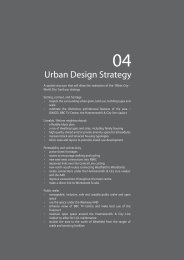Travel in London Travel in London
travel-in-london-report-8
travel-in-london-report-8
You also want an ePaper? Increase the reach of your titles
YUMPU automatically turns print PDFs into web optimized ePapers that Google loves.
4. Performance of the transport networks<br />
Figure 4.3<br />
National Rail – public performance measure for <strong>London</strong> and South East<br />
operators (mov<strong>in</strong>g annual average as at quarter four each year).<br />
100%<br />
98%<br />
Public performance measure<br />
96%<br />
94%<br />
92%<br />
90%<br />
88%<br />
86%<br />
84%<br />
82%<br />
80%<br />
2010/11 2011/12 2012/13 2013/14 2014/15<br />
Source: Office of Rail and Road (ORR).<br />
National Rail crowd<strong>in</strong>g<br />
Crowd<strong>in</strong>g on National Rail is monitored us<strong>in</strong>g the DfT’s passengers <strong>in</strong> excess of<br />
capacity (PiXC) measure. This compares planned capacity on services arriv<strong>in</strong>g <strong>in</strong> or<br />
depart<strong>in</strong>g from central <strong>London</strong> aga<strong>in</strong>st actual demand, with PiXC be<strong>in</strong>g the<br />
difference between the two. Figure 4.4 shows PiXC results (for the morn<strong>in</strong>g peak<br />
period only) from 2008 by tra<strong>in</strong> operator. In 2014 the PiXC value across all<br />
operators (comb<strong>in</strong>ed) <strong>in</strong>creased to 5.4 per cent, up from around 4 per cent <strong>in</strong> the<br />
previous four years. <strong>London</strong> Midland was the only operator to see a reduction <strong>in</strong><br />
crowd<strong>in</strong>g <strong>in</strong> the most recent year, down to 5.7 per cent from 7 per cent <strong>in</strong> 2013.<br />
In the context of cont<strong>in</strong>u<strong>in</strong>g strong growth <strong>in</strong> demand for rail services, significant<br />
reductions <strong>in</strong> PiXC values for <strong>in</strong>dividual operators are usually associated with the<br />
acquisition of new roll<strong>in</strong>g stock and/or the provision of new services. Likewise,<br />
where the network is relatively static, demand growth from year to year would tend<br />
to drive a correspond<strong>in</strong>g <strong>in</strong>crease <strong>in</strong> PiXC values.<br />
Although <strong>London</strong> Overground is notable for hav<strong>in</strong>g PiXC values of zero for each of<br />
the last five years, this measure only relates to the Euston-Watford services (other<br />
parts of the Overground network are not measured for PiXC, as it is a measure<br />
applicable to ‘radial’ commuter routes), and this l<strong>in</strong>e itself benefited from new<br />
roll<strong>in</strong>g stock, offer<strong>in</strong>g higher capacities, <strong>in</strong> 2010.<br />
First Great Western services <strong>in</strong>to <strong>London</strong> Padd<strong>in</strong>gton have the highest morn<strong>in</strong>g peak<br />
PiXC values for the fifth consecutive year, and while the current level is better than<br />
<strong>in</strong> 2010, the PiXC value <strong>in</strong>creased from 9.7 per cent <strong>in</strong> 2013 to 13.5 per cent <strong>in</strong><br />
2014.<br />
82 <strong>Travel</strong> <strong>in</strong> <strong>London</strong>, Report 8








